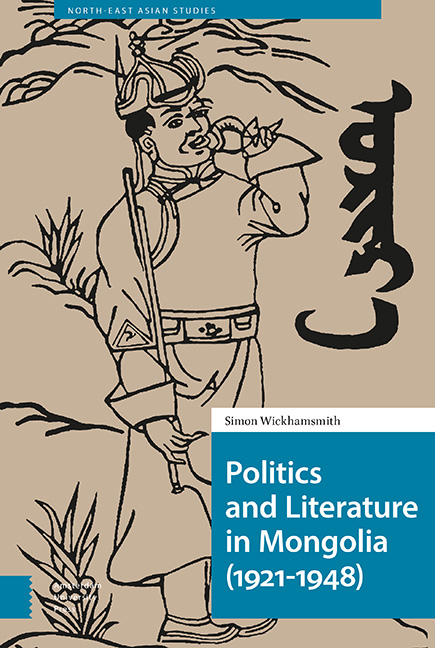Book contents
- Frontmatter
- Dedication
- Contents
- Transliteration and Mongolian Names
- Introduction
- 1 Prefiguring 1921
- 2 Staging a Revolution
- 3 Landscape Re-Envisioned
- 4 Leftward Together
- 5 Society in Flux
- 6 Negotiating Faith
- 7 Life and its Value
- 8 The Great Opportunistic Repression
- 9 A Closer Union
- Appendix: Brief Biographies of Writers
- Index
2 - Staging a Revolution
Published online by Cambridge University Press: 21 November 2020
- Frontmatter
- Dedication
- Contents
- Transliteration and Mongolian Names
- Introduction
- 1 Prefiguring 1921
- 2 Staging a Revolution
- 3 Landscape Re-Envisioned
- 4 Leftward Together
- 5 Society in Flux
- 6 Negotiating Faith
- 7 Life and its Value
- 8 The Great Opportunistic Repression
- 9 A Closer Union
- Appendix: Brief Biographies of Writers
- Index
Summary
Abstract
Since the vast majority of Mongolia's population was illiterate, its revolution was initially acted out upon the stage. Amateur actors and revolutionary youth groups came together – the former portraying the ideological material promoted by the latter – in an attempt to develop a new understanding of, and approach to, theatrical performance. In this way, small theater groups spread across the country, performing ideological education to show, through satire and through historical and social drama, the misery and inequality of pre-revolutionary Mongolia and the benefits the revolution had brought. The influence of Soviet agitprop led to more innovative, amateur productions, while the opening of a national theater in the late 1920s and the arrival of directors – and later actors – from the Soviet Union brought credibility to the theatrical arts and led to professionalized roles for actors, set designers, painters, singers and musicians.
Keywords: literacy, literature of propaganda, amateur theater, youth theater, Red Corners, Sühbaatar Club, Mongolian National Theater
In early January 1927, a Chinese specialist in borderland affairs, Ma Ho-t’ien, attended a performance of a contemporary play in Ulaanbaatar, a description of which he later included in his account of his visit to Mongolia, Chinese Agent in Mongolia. Ma doesn't mention the play's title, and his outline of the eight scenes helps little towards identifying it, but its themes and dramatic trajectory were common elements of Mongolia's theatrical works during the years following the revolution. From the opening scene, as Ma tells it, the social and political focus of the drama is clear:
The curtain rose on a duke and his wife on raised seats, beside which sat a noseless Taiji (noble's son) and a retainer. The family was kitted out in knobbed hats, long gowns and short outer jackets with square designs on front and back. A servant entered and knelt down to address them. He aroused the ire of his masters and was slapped by the retainer until his hat fell to the ground. Some grooms who came to report the escape of their horses were immediately given a sound upbraiding and were remanded to a prince's office for punishment.
- Type
- Chapter
- Information
- Politics and Literature in Mongolia (1921–1948) , pp. 57 - 94Publisher: Amsterdam University PressPrint publication year: 2020



